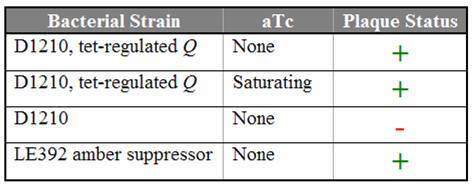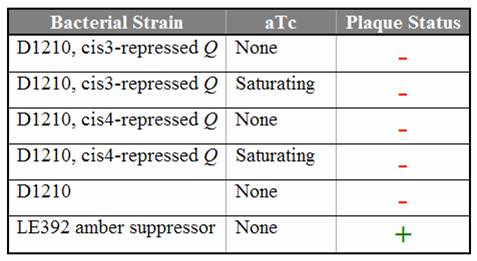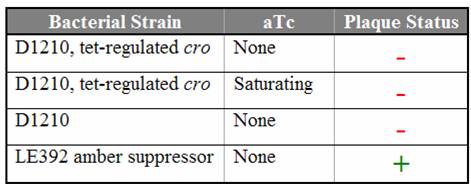Caltech/Project/Titering Results
From 2007.igem.org
iGEM 2007
Home
Highlights
Project
People
Protocols
Unregulated N and QWhen λ phage infects the cell, successful infection is usually predicated on a threshold level of viral protein. Above the threshold amount, lysis occurs. The low concentration of viral protein in aTc-deficient cells would normally prevent viruses from choosing the lytic pathway, yet titration results below show that only small amounts of N and Q protein are necessary for lysis. Even using a strong constitutive promoter to produce tetR, N amber phage infecting our tet-inducible N construct produced plaques both in the presence and absence of aTc. Likewise, aTc addition did not affect the Q amber phage’s ability to lyse D1210 strains containing the Q construct with a slightly weaker promoter expressing tetR. The positive controls (infection of the LE392 strains) show that the amber mutants are capable of lysis in an amber suppressor strain, and the negative controls (infection of D1210 strains without viral protein constructs) prove that the appearance of plaques depends on the presence of the plasmid N/Q construct. N and Q titering results prove that the sufficient viral protein concentrations can rescue the lytic behavior of mutant amber phages. Regulated QHowever, cis-repression of the Q construct using cis3 and cis4 successfully prevented plaque formation. Unregulated croThe titering results for the cro constructs, on the other hand, did not match predictions. Although the cro amber virus successfully lyses the LE392 suppressor strain, no plaques were found on any other cro construct-containing strain (including MG1655 and 7723 E. coli, to prove that the problem does not lie in the D1210 strain alone) even in saturating amounts of aTc. The cro construct was re-prepped and sequence verified, yet the lack of plaques persists in titering. In order the shift focus on the more promising N and Q fronts, the team decided to abandon the cro construct this stage. |




